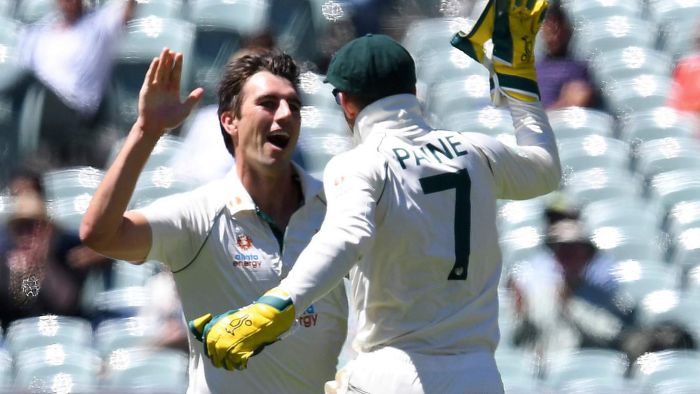During a lower-grade cricket game in a Melbourne park on Saturday afternoon news reached the middle that India had been bowled out for 36.
For a moment, the protagonists abandoned their attempts to relive past glories — or, in this case, repeat past ignominies — and cheered as one.
This scene, I have since been informed, was played out on grounds across the country, where Australia’s astonishing bowling feat was met with a collective: “You bloody bewdy!”
Park cricketers have an obvious affiliation with the national team being near the base of the game’s pyramid — although, it should be noted, only in terms of ability and not in their overall importance to cricket.
However, I think there was some extra zest in the celebration of Australia’s victory that went beyond mere patriotic pride and even the sheer mind-boggling unlikelihood of India’s collapse.
This is an Australian team that has achieved a feat more elusive than bowling out an opposition for 36; one that is not merely admired and respected but also universally liked.
The distinction between results-based admiration and genuine likability is important because in the Australian Test team’s modern history there is a significant proportion of fans that have fallen in and out of love with the nation’s first XI.
The Waugh era, particularly, divided those who had an unbreakable devotion to one of the most stupendously talented and dominant teams of any era, and those whose sensibilities were offended by the crass sledging disguised as “mental disintegration” and the tabloid exploits of the team’s most luminous star Shane Warne.
More recently, Sandpapergate prompted some to turn their backs on the Australian team due to the reflected ignominy of the ball tampering stupidity and, perhaps as much, the clumsily attempted cover-up.
And yet despite (or perhaps because of) the red-faced embarrassment of that incident, the harsh punishments and internal reviews that followed, Australian cricket is now represented by a team on the choirboy side of angelic.
One constantly proving to itself, rather like the universally admired Kiwis with who they shared the number one Test ranking entering the Adelaide Test, that the snarling excesses of previous eras are affectations rather than tactics.
The influence of Tim Paine’s leadership is profound, although it might not have been until Friday evening that his innings-savings 73 not out silenced the final critic of his appointment in a country where captaincy is a role, not a position.
Paine’s great fortune is to have at his disposal an attack that is not merely lethal and disciplined, but that also defies the snarling, fast-bowling stereotype.




Josh Hazelwood’s closest approximation to Dennis Lillee’s hairy-chested machismo is an occasional exasperated grimace, while such is Mitchell Starc’s stoicism, Warne once regularly ridiculed his lack of aggression from the commentary box.
Patrick Cummins’s only known fault is that he seems too bloody good to be true. That was, at least, until the statuesque Cameron Green entered the change rooms and raised the possibility there could be a cricketer both as talented and marketable as Perfect Pat.
Nathan Lyon? Having turned taciturn into a personal trademark, I suspect the offie appeals particularly to cat owners who don’t require the neediness of a labrador or a cocker spaniel in their personal favourites.
Matthew Wade’s gruff on-field persona doesn’t immediately reek of lovability. Wade has undertaken a trade apprenticeship to supplement his post-career income, and you imagine he will be the kind who shakes his head in pity at the state of your plumbing and grumbles beneath his breath about your cluelessness with a wrench.
But if Wade is unlikely to be offered a toothpaste commercial, in the manner he literally puts his body on the line for Australia taking balls on the body rather than risking his blade, you can’t help admiring his courage — and, if he’s not much for small talk, you know he will do a good job on your joinery too.




Marnus Labuschagne? Even allowing for the constant tics and mannerisms that distract some, if you don’t like his almost manic devotion to the game’s minutiae then I would suggest you don’t really like cricket.
Joe Burns’s popularity waned with his batting average before the first Test, although not for any other reason than his selection offended the sensibilities of those who believed he had been given one chance too many.
Yet by the time Burns had top-edged the winning six at the end of one of Test cricket’s most momentous days, who wasn’t warmed by the Queenslander’s grit?
You might still find a few unwilling to forgive Steve Smith for his role in Sandpapergate. But if the ex-captain’s reputation was not rehabilitated during his time in Coventry or by the mountain of runs he scored upon his return, I would suggest the quiet acceptance of his diminished place in the team’s leadership demands respect.
And so to the elephant in the change room — or the one about the return to it — David Warner, who is the sole current Australian player who continues to divide opinions.
Although even if Warner remains on the other side of that infamous behavioural “line” in the eyes of some, I would venture that as the exception to this team’s angelic nature he could be tolerated by even the fiercest critic — particularly while bludgeoning an opposition attack.
Warner certainly does not diminish the impression that this is not merely a tremendous Australian team to watch, but one that is very easy to like.







